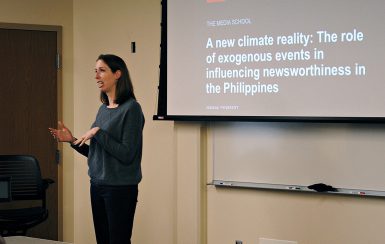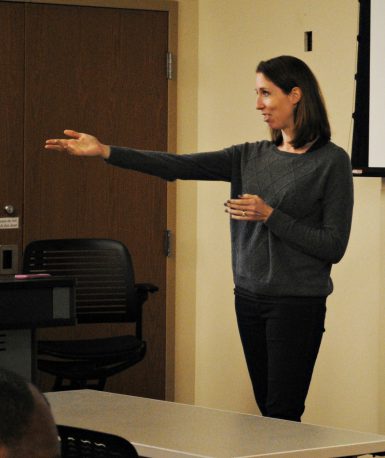Comfort’s research looks at climate communication in Philippines

Discussion of climate change in the media is shaped by sociological constraints and cultural, economic and political forces, according to assistant professor Suzannah Evans Comfort.
Comfort discussed these issues in her talk, “A New Climate Reality: The Exogenous Events in Influencing Newsworthiness in the Philippines,” Jan. 27 as part of the Media School’s weekly talk series.
She introduced the presentation with statistics about climate communication studies. Half of all climate communication studies focus on the United States, Canada, western Europe, India or Australia, she said.
“We have a lot of information about this part of the world,” Comfort said. “What’s going on in the rest of the world?”
Furthermore, there is no overlap between the most studied and most vulnerable nations, Comfort said, including Pakistan, Bangladesh and Haiti. Comfort chose to focus this research on the Philippines because it is a developing island nation with a low sea level. Also, in less rural areas of the country, English is widely spoken.
Thus, Comfort traveled to the Philippines with primary questions in mind: How does a high vulnerability, low emissions developing nation communicate about climate change? What are the sociological constraints on climate journalism there? How did rising typhoon activity in the Philippines increase opportunities for this kind of journalism there?

With conceptual framework based on a ring-shaped hierarchy of influences in mind, examining concepts like social systems and media organizations, Comfort took a historical sociological approach and interviewed Filipino climate journalists at national news outlets in Manila.
“I looked for people who had already written about climate change, which is a minority,” she said.
Comfort also said she found it easier to access activists than journalists during her interview sessions, something that reflects the nature of doing work in an international setting without many personal connections to the people or culture there.
“It was hard to pin down the journalists,” she said. “They’re busy, and they’re not sure why they should talk to me because I’m a stranger from America, whereas activists were way more accessible.”
She concluded through her primary and secondary source research that historically a variety of forces have combined to make environmental and science topics unattractive to reporters.
“There’s not a strong legacy of scientific journalism in the country,” she said. “But, the appearance of these extreme weather events, particularly Typhoon Haiyan in 2013, opened up new opportunities for journalists to talk about climate change, something that had not been viewed as newsworthy shifted into a newsworthy topic.”
Comfort said outside the newsroom, Filipinos rely on advertising and government or official sources to learn about climate issues. The country has low rates of science literacy, and the history of government press control and personality politics shapes people’s understanding as well.
Climate journalism still operates within these historic constraints, Comfort said, but society should keep an eye on the field as it develops.
“We’ve gone from virtually none, in 2008, barely 10 years ago, to now over 2,500 stories a year.”
More:

